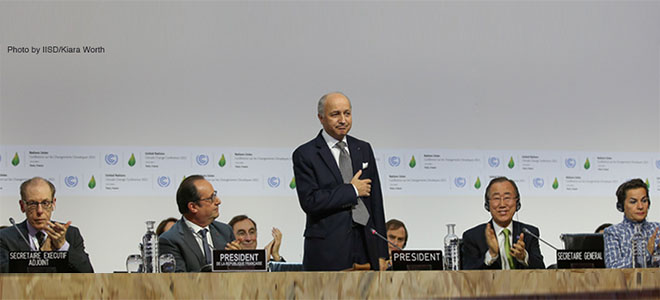CIRES News
December 16, 2015
The 2015 Paris Climate Conference (also known as COP21 – the 21st meeting of the conference of parties ) ended with an agreement this past Saturday. Several of our CIRES and NOAA colleagues attended the conference, including Marilyn Averill from the Center for Science and Technology Policy Research and the Getches Wilkinson Center for Natural Resources, Energy and the Environment. Below is a short Q&A with her about the two weeks she spent in Paris.
Q) What was your role at COP21?
This is my fourteenth COP! My first was at the Hague in 2000 and I’ve been to every one since 2003. Since Copenhagen, in 2009, I’ve been a member of the steering committee for the RINGOs [Research and Independent Non-governmental Organisations to the United Nations Framework Convention on Climate Change] and I ran their daily meetings at COP 21.
There’s so much going on at the COP that there’s no way one person can keep track of it all, so these meetings help keep people up to date on what’s happening around the negotiations. It’s a good home base for a lot of researchers and a way for people to share information about events they’ve gone to and to network with each other.
Q) Fourteen COPs! How was this one different?
It was different right from the outset because there was an actual agreement that people expected would be adopted. The closest to this was Copenhagen, where there were extremely high hopes that an agreement would be reached. It was disappointing when Copenhagen didn’t pan out but that meeting really got people engaged. This time, the negotiations were much further along. There was a huge amount of optimism going in, along with fears that we might not reach agreement, and there was payoff this time.
Q) What were some of the big topics that came up in this meeting?
Laurent Fabius, the French foreign minister and president of COP21, highlighted three issues:
- Differentiation. This is the idea of common but differentiated responsibilities. This is the first time that developing countries were asked to make commitments. Basically, each country brought their own goals for carbon reduction to the table, but there were differences of opinion about just how much differentiation should be attached to various parts of the agreement. Getting commitments from all these different countries – and especially China – was huge, even though each country is making the decision only for itself. Of course, there’s no enforcement system to hold these countries to their commitments – that’s where NGOs can step in. It’s their role to make sure their countries are accountable and keep increasing their levels of commitment.
- Finance. There’s so little funding available to meet these goals and any action we take requires money. It’s been emphasized that all countries have a right to develop. But developing nations will need help if they’re going to develop in a sustainable way. That means the governments of developed nations as well as the private sector will both have to step in.
- Ambition. The target has been to keep global warming below 2°C. The developing world wants that target even lower, at 1.5°C. And we have increasing information about the kinds of injuries that will occur between the 1.5° and 2° level, like the disappearance of some small islands states, damage to agriculture. There’s a sentiment in the developing world that if you use 2°C as the target, you’re writing off those who will be injured as the temperature rises between 1.5 and 2 degrees. The Paris Agreement aims to hold the temperature increase to well below 2°C, and to try to keep warming below 1.5°C.
This agreement isn’t going to save the world by itself. It’s just putting us on the pathway. We’ll need to do more and ratchet up the ambition, find the money, put the work in to keep climate change to levels where there will be fewer injuries. And universities will have key roles in this – climate research, capacity building, innovation, communication, and accountability. Read more …


